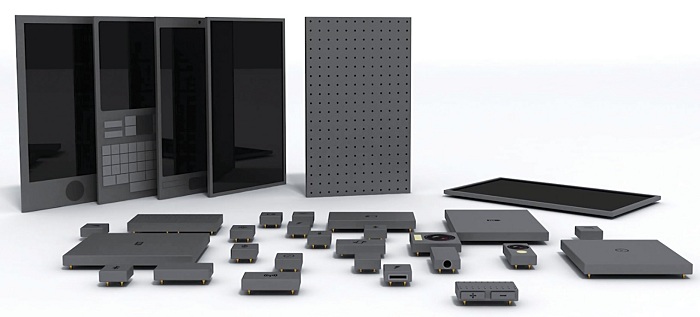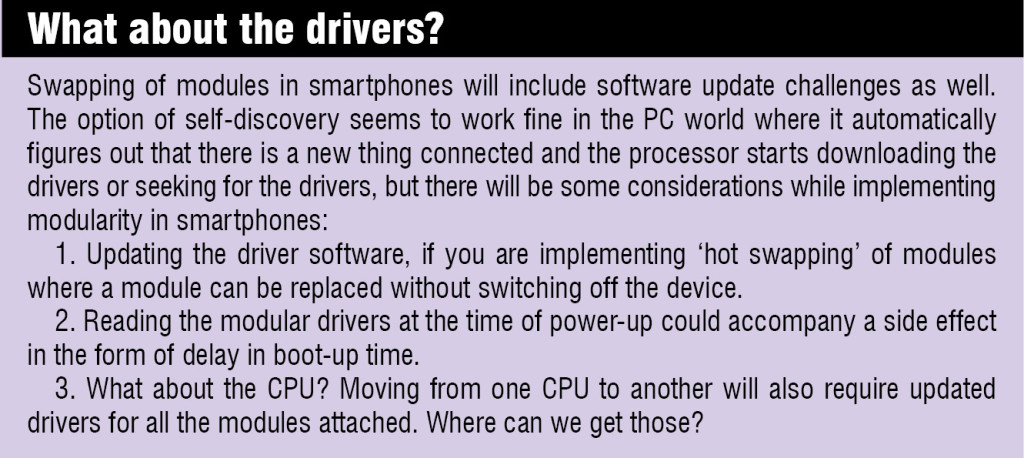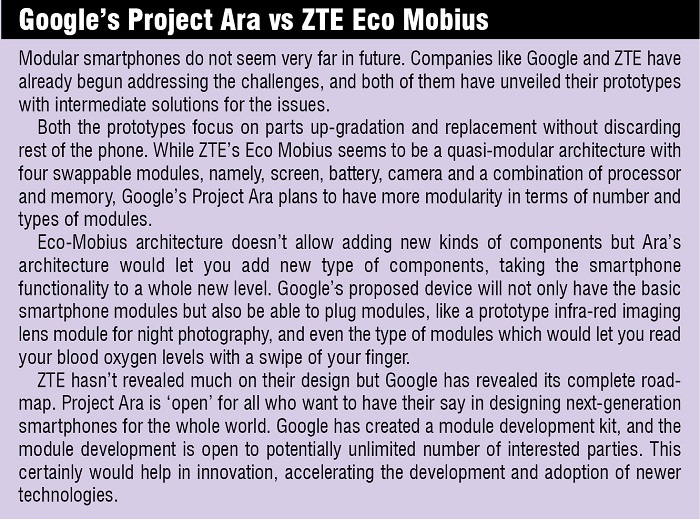Smartphone, one of the most empowering innovations in the modern world, has become an intimate object in our lives. However, the pace with which technology is advancing is shortening its life span. What if we could have a long-lasting modular mobile device that was always at par with the latest technology?

Modularity in a smartphone would mean interchangeable parts, which would provide us the benefits of customising our smartphone exactly the way we want, but upgrading any specific part without changing the whole device. For example, one could choose the desired processor or have multiple camera lens options for the phone. Even if some component failed with use, the user could simply replace the component without having to change the whole device.
The idea seems promising enough to some big players who have already started working on their prototypes. This concept can be easily related to the fact that smartphones are the personal computers (PCs) of future, and the concept of building a modular PC is well established with almost every part replaceable and changeable in any PC. However, the design challenges of building a modular PC the size of a small fridge is different from that of building a modular device which is small, thin, light and depends on a very small power source.
How can we build such a thing?
There are a lot of design challenges and considerations that have to be considered before developing a functional modular smartphone that can withstand the test of time. Let us look at some of the most important elements here.

Open hardware platform. A modular smartphone is an alluring idea but an open platform is a must for a successful design. A modular design with proprietary interfaces and limited availability of modules won’t do any good for the success of the idea over the long term, since the ecosystem surrounding the hardware would fail to grow without an open hardware platform to foster it. An open hardware platform would allow anybody to create own modules, ensuring the creation of a vibrant third-party developer ecosystem, lowering the entry barriers and increasing the pace of innovation by substantially compressing the development time-lines for these modular smartphones.
Standardised base module. No doubt the smartphones are incredibly compact devices, and different components are fitted into a compact body, but the modular concept of replaceable parts forces us to think differently. The design calls for a standardised base module on which self-contained units of different modules can be connected/disconnected.
A standardised base module would ensure some control over the platform and also make sure there is enough cohesion in the developer community. The whole customisation will revolve around this base module.
A standardised base module will make sure everything fits together and works. This base module should constitute different slots to connect or disconnect the replaceable modular components. It could also have a small reserve battery, which is necessary to swap the other modules, especially the external battery module.
According to some experts, it would be a good choice to have very little functionality other than just transferring data packets within different modules on the base module. This would keep the basic cost down and ensure enough space for enhancing modular functionality.

The open hardware platform comes with a side effect as well. The device could crash or stop functioning on connecting a sub-standard module designed by some other manufacturer. So, an important consideration while designing the base module would be to include enough safeguards for thermal and power management built on to it. This would secure the device from any functional hazard, if any bad or sub-standard module is connected, thus ensuring normal functioning of the device after the removal of such module.
Interfacing
Connectors between the main base unit and the other modules are also a big performance challenge. If we see integrated designs, these are set up for high performance. Connectivity between different units is highly optimised, but breaking this up and building external connectors that operate at similar performance levels would be a huge challenge.
Any external connector connecting different modules would give the device a ‘Lego’ kind of look, while at the same time making it bulkier. Moreover, such a modular system would consume more power, since hot swappable and standard connectors would now replace the more fine-tuned custom connections.
Will connectors be the knell of doom?
Well we have alternatives; the device doesn’t have to be connector based in the first place. Today, we have architectures which do not require any connectors, by having their electrical interfaces defined in the mechanicals of the device itself. This way the PCB of any module can be connected with the PCB of the other modules without the standard connectors. Or the casings of modules could have embedded electrical interconnects to connect the modules.
Nate Srinath, founder-director, Inxee, explains, “If we look at the phones today, we are moving towards thinner and thinner architectures, so most connectors available are big for these. We have to look for very fine customised, thin connectors which are very durable and can make multiple modules connect. Some architecture doesn’t have any connectors but the electrical interfaces are defined in the mechanicals itself. If we can dream, there are so many ways to do it, but the bottom line is somebody has to standardise it and then make everybody adhere to it.”
Let’s talk solutions
A plausible solution could be electro-permanent magnets. Electro-permanent magnets are passive in both on and off states and can be used to transfer data as well as power. These require a voltage for transition between two states and their off-state magnitude is lower. But when turned on, their magnitude increases many folds, which is good enough to hold different modules. Also, eliminating any external connector, these connections would allow the device to be slim and maintain its aesthetic looks.
Another contact-less power and communication interface technology which might help is capacitive media converter. The technology is still in development phase where coupling occurs by capacitance at higher frequencies and inductance at lower frequencies. Experts believe that if connectors are avoided, it could also help in reducing the additional industrial design overheads related to increased volume and weight.
But one needs to carefully consider contact and contact-less options while going for the connections between modules. Ashwin Ramachandra, VP and head, ErND Practice, Sasken Communication Technologies, explains, “The moment you look at contact-less options, a new problem immediately comes up. Integrating issues with respect to signal, power and bandwidth will definitely be there. But for the areas like when you are connecting the processor with memory you can’t afford to overlook these issues, you need a fairly strong connector or a critical line connecting processor to the memory.”
Swapping those modules
A modular phone presents the idea of swapping different modules and configuring the phone features by ourselves. But how can we really swap a camera module with a battery module, or a memory module with a Wi-Fi module?
Actually, the solution is pretty straightforward but it does have some considerations. For such a system, you would have to define a standard interconnect architecture and make the modules intelligent so that they know who they are talking to. Making each module ‘smart’ or intelligent will not be much of a challenge as we have many low-power and optimally-powerful processors available to do the job.
This way the base module or the main master or the controlling module can easily make decisions on what kind of module is attached to it; it can be a camera or a battery or any other module. Now everything will only depend on how much area we want to use and what kind of functionality we want to have in the phone.
Some people suggest that we can also have architecture of common control bus and have the modules complying to the control architecture, with a separate data bus which takes care of data. Ashwin Ramachandra, Sasken Communication Technologies, explains, “Looking it from signalling perspective, you need to start looking at signal flows and then identify control signals. If you are able to create a backplane where all your signals flow on one particular set of lines, you are beginning to establish something like that.”
We can actually borrow some mechanisms from existing technologies as well. Ashwin adds, “If you go to the automotive segment, there is something called a CAN bus. Let’s say, if you start loading your operating system and a signal goes on to your CAN bus, the CAN bus has a mechanism of arbitrating and then trying to figure out how to start communicating with the signal.”
However, such solutions will also carry with them complexity issues.
Power concerns
As already discussed, by making the phones modular one thing we are doing is, having an architecture where we are adding connectors (or interfaces), and in the process of adding these we are adding a lot of communication chipsets. This is going to make a significant impact on the power requirements of the device.
Also, if we are making the modules intelligent enough to be swappable, every module will have a computing element on it, and instead of one computing element now we will have multiple controllers, which means additional power requirement.
Increasing the amount of intelligence on the device will only add to power requirements and power needs will increase in proportion to the number of modules we have on the device.
If we just have a single physical PCB, the shortest route is much smaller. But if you are drawing wires across components, obviously we are taking a longer route. Pure physics tells us that we need extra assistance if we are taking up such a design, which directly affects the performance as a power consumption issue.
RF behaviour
RF behaviour is one of the most significant aspects of regulatory approval for any device. While the industry is still waiting for a functional prototype to test RF behavior on a modular device, many experts predict that the modular architecture would show better RF response.
Nate Srinath, founder-director, Inxee, says, “RF behaviour should have no impact here, or in-fact in modular architecture it will be even better. In our experience we have seen that the more we isolate RF interfaces, the performance gets better. It happens so because when we have the integrated PCB, lot of noise issues from other components like the battery, LCD or the touch sensors have an impact on the RF signalling. But as we will move towards modular, we will actually isolate all of the RF components from the other parts of the system, so modular will actually make the performance better.”
Other challenges
The whole project of modular smartphone is a big challenge. Most mobile phone manufacturers are focused on reducing sizes of the phones for better user experience and looks. The current integrated design allows designers to innovate in areas such as curved displays or higher-resolution cameras.
But when we talk about a mobile phone, a major concern is the form factor. Making the device more modular will definitely impact on size of the device. We can easily predict that, with a modular architecture size of the phone is only going to increase. So, keeping the form factor same for the modular device will be a challenge for the designers and engineers.
The other issues that should be taken care of while designing a modular device would be liability and overall ruggedness of the modules. What will happen if the device is dropped? If it starts coming apart then we have an issue. Additionally, the modules and interconnects must be rugged enough to handle frequent plugging and unplugging.
Besides, today’s non-modular devices are made to resist mechanical shocks in terms of functionality as well. Ensuring the same thing with the modular device will be a bigger challenge. We need to engineer for the fact that mechanical shocks have least impact on the performance of the individual modules as well as the overall body.
A feasible technology standpoint
Modular architecture in smartphones is challenging but it opens up a new area of research which is probably going to be very exciting for the engineers. It is definitely a feasible technology standpoint but the associated considerations must not be sidelined.
When a device becomes mobile or mobility oriented, we take care of many issues. But if we are going modular, we are actually increasing those engineering challenges that are not going to be very easy to solve.
The key focus in the modular designs would be to ensure there are common communication and interface mechanisms at both hardware and software levels. As long as the modules adhere to these specifications, these issues would be addressed.
The author wrote this as a technical journalist at EFY. He recently opted and shifted to the hands-on training division of EFY













